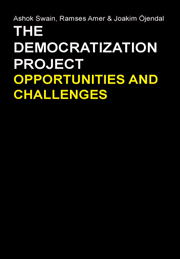Book contents
- Frontmatter
- Contents
- List of Tables
- List of Figures
- Acknowledgements
- Contributors
- The Democratization Project: Opportunities and Challenges
- 1 The Democratization Project: Peace, Conflict and Development
- 2 Non-Authorized Military Interventions and Legitimization by the United Nations
- 3 From Condemnation to Legitimization of Outcome: The United Nations and the Use of Force in Inter-State Relations
- 4 Demos or Deus: Patterns of Religious Dimensions in Asian Armed Conflicts, 1945–2005
- 5 The Left and Democratic Consolidation – Deepening Democracy in Latin America?
- 6 Democracy without People? – The Risk of Monopolizing the Democratization Project
- 7 The Role of Hamas in Building Palestinian Democracy in the Midst of Violence
- 8 Elections and Violence in Sri Lanka: Understanding Variation Across Three Parliamentary Elections
- 9 Post-Accord Elections and Armed Conflict
- 10 Peace Through Democracy? The Challenges of Postwar Democratization in Weak and War-Torn States
3 - From Condemnation to Legitimization of Outcome: The United Nations and the Use of Force in Inter-State Relations
Published online by Cambridge University Press: 05 March 2012
- Frontmatter
- Contents
- List of Tables
- List of Figures
- Acknowledgements
- Contributors
- The Democratization Project: Opportunities and Challenges
- 1 The Democratization Project: Peace, Conflict and Development
- 2 Non-Authorized Military Interventions and Legitimization by the United Nations
- 3 From Condemnation to Legitimization of Outcome: The United Nations and the Use of Force in Inter-State Relations
- 4 Demos or Deus: Patterns of Religious Dimensions in Asian Armed Conflicts, 1945–2005
- 5 The Left and Democratic Consolidation – Deepening Democracy in Latin America?
- 6 Democracy without People? – The Risk of Monopolizing the Democratization Project
- 7 The Role of Hamas in Building Palestinian Democracy in the Midst of Violence
- 8 Elections and Violence in Sri Lanka: Understanding Variation Across Three Parliamentary Elections
- 9 Post-Accord Elections and Armed Conflict
- 10 Peace Through Democracy? The Challenges of Postwar Democratization in Weak and War-Torn States
Summary
Purpose and Structure
The United Nations Security Council has become dramatically more active since the end of the Cold War. This is evident in terms of the number of resolutions adopted, particularly the number of resolutions adopted under Chapter VII of the Charter of the United Nations, as well as in the number of peacekeeping missions and mandatory sanctions regimes. The main aim of this study is to assess if this increased activity of the Security Council in the post-Cold War Era has been accompanied by a corresponding increase in the effectiveness of the Council. This is done by analyzing the pattern of Security Council reactions to the use of force in inter-state relations. The prohibition of the use of force, other than in self-defence, is one of the most fundamental rules that the Council is assigned the responsibility to uphold. We assess the Security Council's reactions to the use of force in inter-state relations through its pattern of reactions to foreign military interventions.
The structure of the study is as follows. First, the regulation of the use force in the Charter of the United Nations is described, and the main arguments of the international legal debate regarding these regulations are outlined. Second, the activities of the Security Council in the post-Cold War Era are presented. Third, the pattern of Security Council reactions to foreign military interventions is outlined. Fourth, the trends in Security Council behaviour are assessed.
- Type
- Chapter
- Information
- The Democratization ProjectOpportunities and Challenges, pp. 39 - 66Publisher: Anthem PressPrint publication year: 2009

